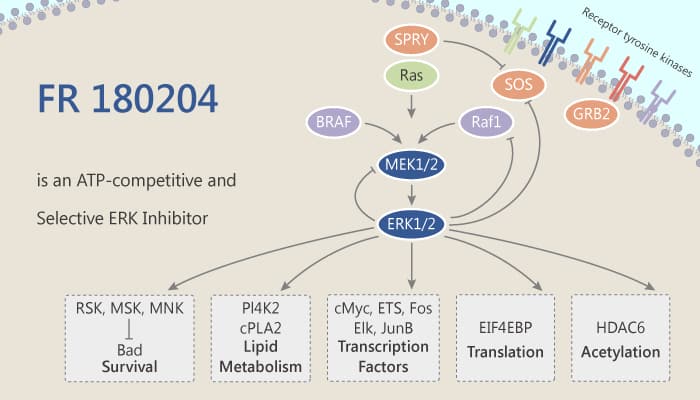An extracellular signal-regulated kinase (ERK) is a serine/threonine-protein kinase of the mitogen-activated protein kinase superfamily. Selective inhibition of ERK represents a potential approach for the treatment of cancer and other diseases. Simultaneous targeting of multiple effectors such as RAF, MEK, and ERK offers the potential for enhanced efficacy while delaying and overcoming resistance. In particular, ERK cascade plays a crucial role in multiple cellular processes such as cell proliferation, differentiation, adhesion, migration, and survival. As a result, targeting ERK may hold a promising prospect for cancer therapy.
In this study, Makoto Ohori, et al performed a high-throughput phosphorylation assay to identify compounds that inhibit ERK-mediated phosphorylation of myelin basic protein and identified FR 180204. FR180204 is a selective and cell-permeable ERK inhibitor. FR 180204 inhibits ERK1 and ERK2 with an IC50 value of 0.51 μM (Ki=0.31 μM) and 0.33 μM (Ki=0.14 μM), respectively. ERK plays an important role in TGFβ signaling using this selective inhibitor. In mink lung epithelial Mv1Lu cells, FR 180204 inhibits TGFβ-induced luciferase-expression. Meanwhile, FR 180204 dose-dependently inhibits AP-1 transactivation, with an IC50 of 3.1 μM. Moreover, FR 180204 inhibits TGFβ-induced AP-1 activation in Mv1Lu cells. Furthermore, FR 180204 inhibits LPS-induced PARP-1 activation and high-mobility group box protein 1 (HMGB1) release.

FR 180204 ameliorates collagen-induced arthritis in mice. Further, FR 180204-treated mice show a significant decrease in plasma anti-type II collagen (CII) antibody levels (62%). FR 180204 attenuates myocardial hypertrophy in Isoproterenol-treated Pak-1-knockout mice.
To summarise, FR 180204 is an ERK-selective and cell-permeable inhibitor for elucidating the roles of ERK as well as for drug development.